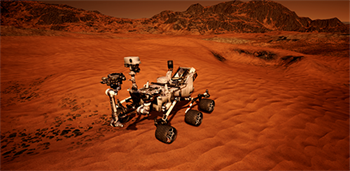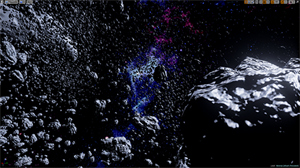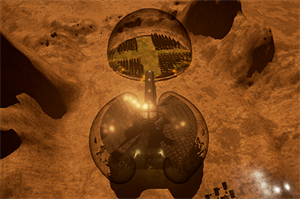 Strap on a pair of virtual reality (VR) goggles and pilot a spaceship around an asteroid field or explore the terrain of Mars. Participants at South by Southwest (SXSW) were able to do just that through the SpaceCRAFT VR platform that is being developed by Dr. Greg Chamitoff, professor of practice in the Department of Aerospace Engineering at Texas A&M University, and his students under the advisement of NASA.
Strap on a pair of virtual reality (VR) goggles and pilot a spaceship around an asteroid field or explore the terrain of Mars. Participants at South by Southwest (SXSW) were able to do just that through the SpaceCRAFT VR platform that is being developed by Dr. Greg Chamitoff, professor of practice in the Department of Aerospace Engineering at Texas A&M University, and his students under the advisement of NASA.
SpaceCRAFT is a new concept for collaborative space system and mission design. It is a VR “sandbox” environment designed to enable government, university and commercial entities to collaborate in the design, use and evaluation of technology for future operations in space.
“The idea behind SpaceCRAFT is that the future of space exploration can be fully simulated and experienced virtually before we go and even before we build the systems that we'll need,” says Chamitoff. “Perhaps even more importantly, with SpaceCRAFT it is possible for individuals or organizations from anywhere in the world to collaborate on space systems and mission design.”
Humanity’s future will be greatly influenced by the evolution of space exploration and habitation over the next century. Future missions of exploration and settlement in space will involve many technologies, systems and capabilities working together on a solar system scale, including numerous spacecraft, habitats, rovers, robots, satellites, constellations, communication arrays, space suits, landers, scientific instruments, life support systems and tools, such as teleoperation and advanced autonomous systems for robotic construction and other remote operations.
 Today it is impossible to test a complete space mission architecture in any integrated fashion, especially one with components designed and developed at different institutions around the world. SpaceCRAFT provides a way for scenario-based testing in an integrated mission VR environment.
Today it is impossible to test a complete space mission architecture in any integrated fashion, especially one with components designed and developed at different institutions around the world. SpaceCRAFT provides a way for scenario-based testing in an integrated mission VR environment.
“SpaceCRAFT is an online virtual reality collaboration tool that makes it possible to integrate system designs from all aspects of a mission, and to perform human-in-the-loop testing of the design and operations. It allows users to share, connect and test system models within a high fidelity simulation of the space environment that can be also be experienced directly by the user,” says Chamitoff.
SpaceCRAFT will enable countless individuals and institutions from around the world to collaborate and contribute to the future. The platform allows users to share their models publicly for worldwide testing and improvement, or privately for collaborative work between specific entities. The aim is to enable any person or institution to contribute to humanity’s future in space.
 The name SpaceCRAFT is inspired by the popular game Minecraft, in which users can meet in a virtual environment, build infrastructure and play together from anywhere in the world. At the core of SpaceCRAFT is a model of the solar system, the planets and other bodies of interest and the basic laws of physics. Details such as planetary surface features, the radiation environment, atmospheric properties and models of actual or simulated space vehicles or systems can all be “plugged in.”
The name SpaceCRAFT is inspired by the popular game Minecraft, in which users can meet in a virtual environment, build infrastructure and play together from anywhere in the world. At the core of SpaceCRAFT is a model of the solar system, the planets and other bodies of interest and the basic laws of physics. Details such as planetary surface features, the radiation environment, atmospheric properties and models of actual or simulated space vehicles or systems can all be “plugged in.”
Depending on the mission, systems and scenarios being evaluated, different models are included. For example, a space suit operability test might require models of the suit and models of the planet surface, including texture, gravity and the tools to be used for a particular operation by a crew member.
During SXSW, participants were able to try out one of three mission scenarios through the use of virtual reality: a Martian habitat with real terrain topology in which radiation dosage, oxygen level and bodily exertion were measured for the virtual character; an asteroid field in which the participant piloted a spaceship aided with thruster selection logic; and an artificial gravity base in which a participant could observe the effects on an object’s motion due to the base’s rotation.
The SpaceCRAFT platform provides the essential abilities to collaborate online, run VR simulations and integrate models from a wide range of tools, including AutoCAD, Matlab, SolidWorks, SketchUp, Labview, GIS, 3DS Max and others.
 “The exciting thing about SpaceCRAFT is that if we create it right, it can be the platform on which humanity's future off-planet Earth is designed, built and tested,” Chamitoff says. “Given the technology we have today and the direction it is going, there is no reason that we should not fully experience the future well before we build it.
“The exciting thing about SpaceCRAFT is that if we create it right, it can be the platform on which humanity's future off-planet Earth is designed, built and tested,” Chamitoff says. “Given the technology we have today and the direction it is going, there is no reason that we should not fully experience the future well before we build it.
“This gives us the opportunity to make sure that we get it right. Through the advice of NASA on this project, it is our intent and hope that it will ultimately be released publicly in the form of a space design competition that will include university students around the world.”
The development of SpaceCRAFT began in September 2016 with more than 75 students on 12 teams contributing to the system architecture, physics models, plug-in capability and demonstration missions. Initial system and mission designs included an operational Mars habitat, rendezvous and docking with an asteroid-based facility, teleoperation of a robot on Mars, a spacesuit simulation, a rescue spacecraft using atmospheric drag and lift for orbital targeting, navigation for a free-flying robot outside the International Space Station, simulation of an artificial gravity space habitat, and more.
Each of the projects contributed core models to the SpaceCRAFT platform, such as atmospheric models, artificial gravity, orbital mechanics, planetary surface models from actual data, dynamics and control models, and more.
An “Aggie Challenge” course with multidisciplinary teams from aerospace, computer science, planetary science, electrical engineering and other departments has been designing the SpaceCRAFT collaborative online platform. The AERO 401/402 class is contributing through their Spacecraft Design Project. And collaboration is ongoing with the University of Sydney and several NASA advisors.
“The combination of space exploration and virtual reality seems irresistible to students that are passionate about the latest technology and on making a difference in their career and other pursuits. We have found that the graduate and undergraduate students who have been involved with SpaceCRAFT are very excited about its vision. Perhaps it's the idea of designing the future and experiencing those designs virtually, but whatever it is, the enthusiasm among students working on SpaceCRAFT has been tremendous,” says Chamitoff.
SpaceCRAFT is a concept developed by Chamitoff with his colleagues Dr. Sharath Girimaji and Dr. Daniele Mortari, professors in the Department of Aerospace Engineering. The evolution and development of the platform has been led by graduate students Mauricio Coen, Robert Hogan and Neil McHenry.
 The objectives for 2017 include the demonstration of the online version of SpaceCRAFT’s project management site as well as multiple users collaborating to build integrated simulations for the program. The team hopes to have an online library of built-in and user-built models, including ratings and blogs. The other objectives are to have plug-in capability for a wide range of engineering CAD and modeling tools, as well as have the capability for multi-user simulation.
The objectives for 2017 include the demonstration of the online version of SpaceCRAFT’s project management site as well as multiple users collaborating to build integrated simulations for the program. The team hopes to have an online library of built-in and user-built models, including ratings and blogs. The other objectives are to have plug-in capability for a wide range of engineering CAD and modeling tools, as well as have the capability for multi-user simulation.
Once these objectives are realized, SpaceCRAFT will be released in Beta form. The platform will be open source, meaning anyone who downloads the free software will be able to build and add any models or structures, limited only by their imagination.
Taking advantage of the latest technology in virtual reality, future space exploration and design can be designed and tested right here on Earth. This technology also opens up parallel opportunities using spin-off platforms for remote collaboration on a wide range of complex projects.